FEATURES|THEMES|People and Personalities
Dialogue Within and Without: Tibetan Artist Tenzing Rigdol on Looking After Artists and Buddhism in the Czech Republic
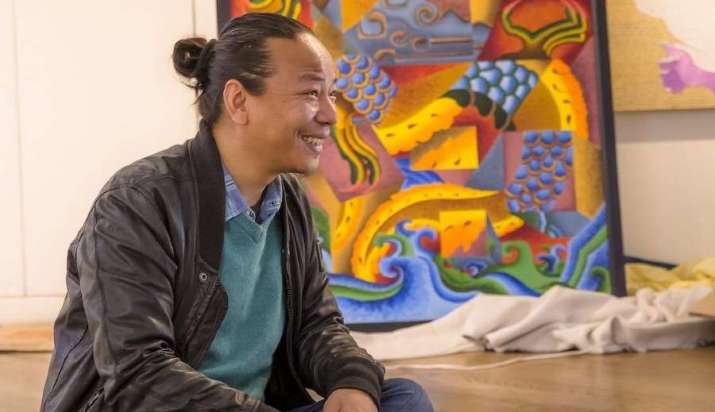 From news.ucdenver.edu
From news.ucdenver.eduBorn in 1982, Tenzing Rigdol is one of the few Tibetan artists who have a truly global reach. Recently, his art was the subject of an exhibit at Rossi & Rossi in Hong Kong from 20 July to 21 September. The exhibit was called Dialogue, and displayed some of his most distinctive work, among them “The Storm in the Fragrant Land,” “Landscape,” “Biography,” and many more. He famously combines traditional Tibetan iconography with contemporary pop culture or political references, which have made him a controversial yet fascinating figure in artistic and religious circles. Vajra bells, wrathful deities, and Tibetan animals intermingle or are fused with Mickey Mouse or geometric lines. One can find recurring motifs that are both thematically and visually consistent, lending an aesthetic consistency to his art.
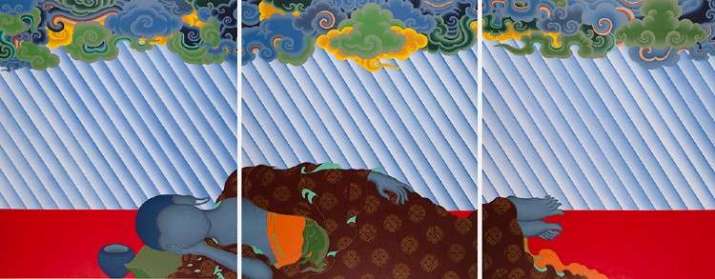 Landscape 2015. Acrylic on canvas, 178 x 453 cm. From artasiapacific.com
Landscape 2015. Acrylic on canvas, 178 x 453 cm. From artasiapacific.comHis long-term project is a Tibetan artists’ residency in Dharamsala, founded in 2014 and called Dialogue Artists Residency. “Tibetans and Indians see the value in sponsoring a residency for monks or practitioners who wish to go on retreat,” he observes with wry amusement, “but not for artists. They don’t see why it’s necessary. Yet it is critical; Tibetan artists need a residence. They’re really talented but they need to de-stress, relax, and have time to themselves to find their creative center.”
Now in its sixth year, Dialogue Artists Residency consists of two buildings, and there are plans to build a third floor, complete with a table tennis table and meditation room, that can host a small number of Tibetan artists and artists from elsewhere. “The Dharamsala artists’ residency has yoga, meditation, and all these Mind and Life-associated activities. When I was living and working in America, I looked at some artists’ residencies but quickly learned that we needed something different for Tibetans in India.”
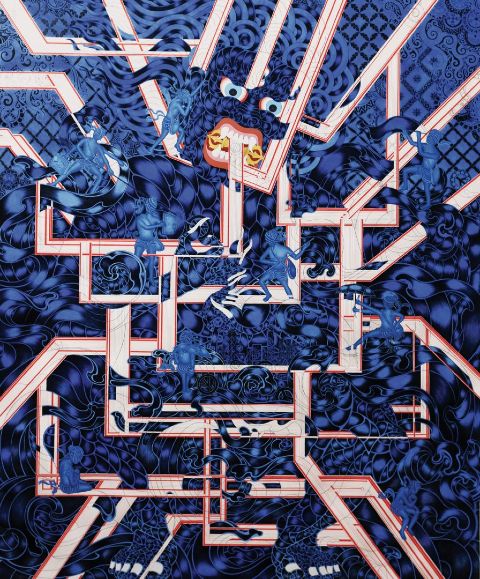
The Storm in the Fragrant Land 2019. Watercolour, charcoal and ink on paper, 160 x 131 cm. From hk-aga.org
“We started very small, and I haven’t advertised it online—it’s been mostly word of mouth,” he said of the Dharamsala residency. “However, Tibetan artists have found it very valuable and they want to protect it, to keep it going. I would say we have helped forty to fifty artists in total so far. We really take their needs into account and connect them to galleries, publishers, and agents . . . it really helps them. And if they’re ill, we help to send them to the hospital. Some of the artists have psychological issues and emotional problems: after all, they are people in-exile. Many of them haven’t seen their family or relatives for decades. Dharamsala is very interesting, as a community. One section is all about meditation, one section is all for tourists or art. There are a lot of bubbles within bubbles. The energy is very strong and vibrant, even if it looks very quiet.”
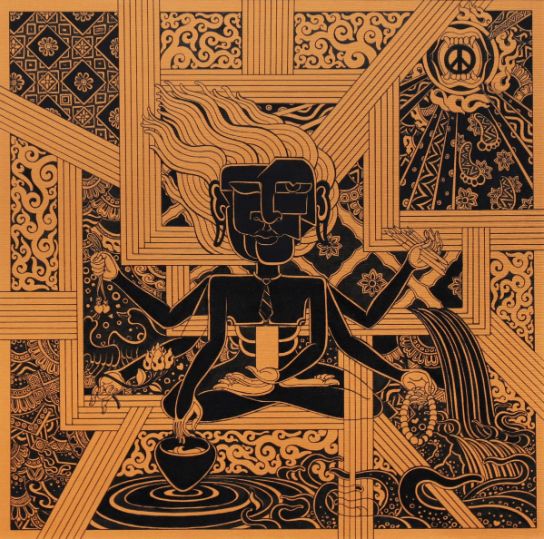
Biography 2019. Ink on paper. 30.5 x 30.5 cm. From timable.com
Tenzing does not have a formal program of instruction or “deliverables” for artists to meet in Dharamsala. “I don’t want them to go crazy so I don’t put any pressure on them. I just encourage them and let them make art in the way they feel comfortable with,” he said, especially as many of them come from deprived backgrounds. “So far they feel very well-supported. Even in India, Tibetans initially didn’t see the need for a residency specifically for creative professionals. They said to me, ‘why do you need to look for funds or support for such a project?’ It was nothing bad, but just a bit of prejudice: they couldn’t empathize or imagine the necessity. In many people’s minds, meditators need a residency, not artists. However, they are now beginning to see that artists are also important and need space for themselves too.”
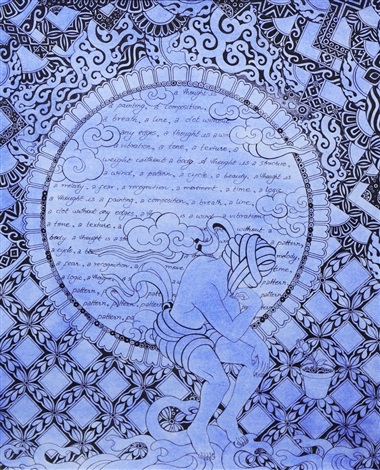
A Thought Is a Painting 2019. Ink and watercolour on paper. 33 x 26.6 cm. From artnet.com
Tenzing also co-founded the Association for Tibetan Art and Culture with Alexandra Kallay, the organization’s present managing director. One of the activities of this NGO is to establish a Czech equivalent of the Dialogue Artists Residency. Both Alexandra and Tenzing hope that the art that comes from the Association’s artists can be displayed at a venue in Prague. For now, this remains a prospect in the medium-to-long term, but the vision is hopeful because there is a precedent that provides a model and inspiration to others. This source of inspiration is Kotera Waterworks, a renovated water tower in Trebon (an ancient town whose history dates back to the 12th century).
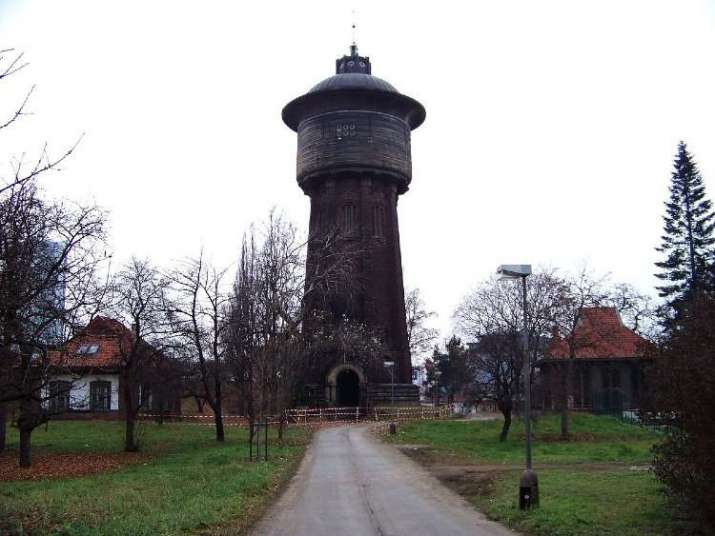 Kotera Waterworks. From cs.wikipedia.org
Kotera Waterworks. From cs.wikipedia.orgWhen I first met Alexandra, who was also an attendee at the third Samvad conclave in September, she told me about Kotera Waterworks, which houses a gallery of Vajrayana art from Mongolia, many of which are owned by the Czech National Museum, and the rest belonging to Milan Klecka, a Trebon local and friend of Mongolia. The gallery is spread across two floors, with visitors able to enjoy a 360-degree view of the artwork while walking up the spiral staircase that frames the spatial ambience of the gallery. Kotera Waterworks represents one of the first successful large-scale collaborative projects between multiple individuals and institutions in showcasing Vajrayana art and heritage. Tenzing and Alexandra hope to accomplish something similar through the Association for Tibetan Art and Culture.
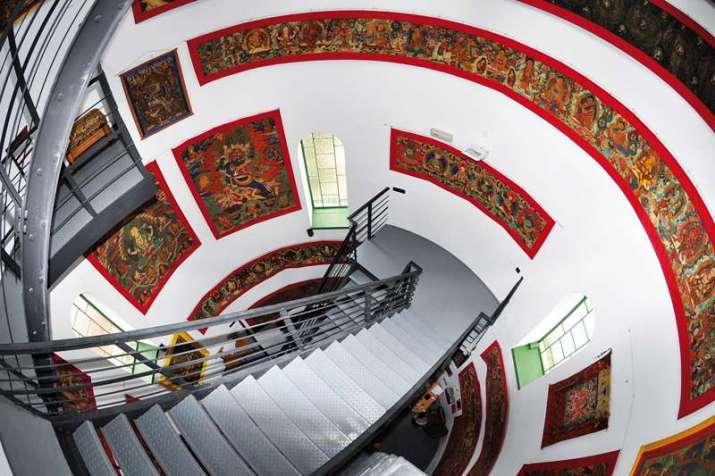 From vtei.cz
From vtei.czTenzing notes that even he is not sure why the Czech community as a whole has been disproportionately supportive of Tibetan culture and art. I believe it has to do with the continual disillusionment among young and freethinking Czechs with politics, and a natural skepticism that is comfortable with the Western expression of Vajrayana Buddhism. This means a path of self-discovery with a clear spiritual direction but with an option to have less emphasis on the institutional ties that form religious establishments and hierarchies, which many Czechs are very suspicious of. Tenzing speculates that it might have been due to the very special friendship between His Holiness the Dalai Lama and Vaclav Havel, the first president of the post-Soviet Czech nation. “I certainly think their bond is a historical reason for why Czechs are so interested in Buddhism. But deep down I think they love the idea of Tibetan culture, of practice and spirituality.”
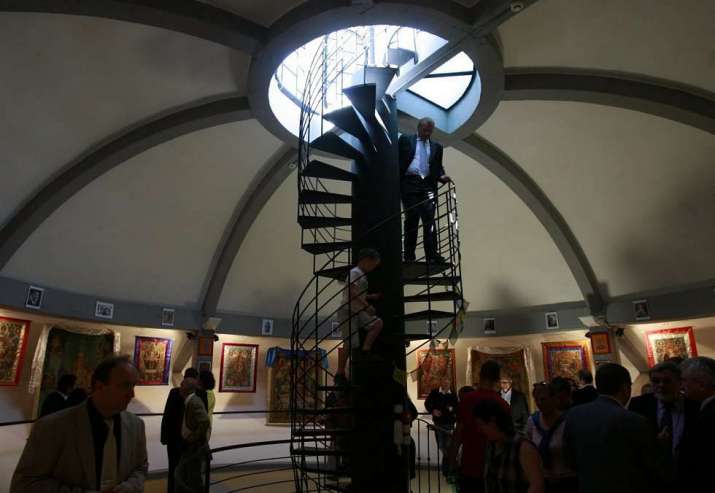 From ceskobudejovicky.denik.cz
From ceskobudejovicky.denik.czTenzing has a gentle and calm demeanor that seems open and willing to what the future holds for his art and his community’s culture. Even as his art is displayed in major galleries in cities like London and New York, he continues to build a bridge between the global community and painters who have yet to reach his level of exposure. “You could even say this is my kriya-yoga, my action. We should use every opportunity to improve ourselves, and when people see our sincerity they will naturally be interested and want to get involved.”
Related features from Buddhistdoor Global
Jacques Bacot’s Rebel Tibet, Part One: Early 20th Century Travels to Kham
Jacques Bacot’s Rebel Tibet, Part Two: From the Great Temples to Early Modern Tibetology
Tibet on the Silk Road from a Curator’s Eye: An Exhibition Tour with Dr. David Pritzker
The Special Friendship of Vaclav Havel and the Dalai Lama, Born from the Emergence of Freedom in Post-Communist Czechoslovakia














